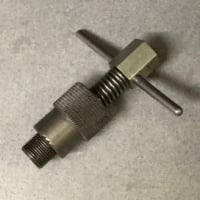Welcome! Here are the website rules, as well as some tips for using this forum.
Need to contact us? Visit https://heatinghelp.com/contact-us/.
Click here to Find a Contractor in your area.
If our community has helped you, please consider making a contribution to support this website. Thanks!
Under floor heating with crazy subfloor?
Options
nSTP
Member Posts: 10
I'm a DIYer with a house built in 1908. I'm hoping to add heat to my kitchen tile floor. We looked into removing the tile, adding something like warmboard and new tile on top but the work involved and costs meant we might as well just remodel the entire kitchen. We aren't quite at that point yet, so I wanted to explore under floor heating options. We currently have a newer Triangle Tube modcon with radiators. The kitchen is poorly insulated and under-heated right now with just a small cast iron radiator on a far corner and a hydronic toekick heater.
The subfloor is a bit of a mystery. The current kitchen was installed by a previous owner so not exactly sure how they buillt the floor up. The basement is unfinished underneath and I've had some pro opinions that half of kitchen used to be a 3 seasons porch that they built over. The subfloor on the half of the kitchen appears to have several layers with the original porch floor slanting downward to the end wall. It looks like they used furring strips to level the subfloor, so there is actually an air gap that gets progressively wider as you approach the outside wall. At its widest gap, it looks like about an inch. So I think I'm looking at 3/4 inch with 1 inch to 0 inch air gap with another 3/4 inch and then the ceramic tile. The other side of the kitchen looks like a normal (but very old) subfloor.
Am I correct in assuming heat plates would not work because of the air gap? Would a product like ultra-fin work underneath this wonky floor or am I out of luck?
The subfloor is a bit of a mystery. The current kitchen was installed by a previous owner so not exactly sure how they buillt the floor up. The basement is unfinished underneath and I've had some pro opinions that half of kitchen used to be a 3 seasons porch that they built over. The subfloor on the half of the kitchen appears to have several layers with the original porch floor slanting downward to the end wall. It looks like they used furring strips to level the subfloor, so there is actually an air gap that gets progressively wider as you approach the outside wall. At its widest gap, it looks like about an inch. So I think I'm looking at 3/4 inch with 1 inch to 0 inch air gap with another 3/4 inch and then the ceramic tile. The other side of the kitchen looks like a normal (but very old) subfloor.
Am I correct in assuming heat plates would not work because of the air gap? Would a product like ultra-fin work underneath this wonky floor or am I out of luck?
0
Comments
-
If your floor can hold the weight, or you can sure it up, best might be a wet bed (mud job) with the tubing embedded. It can go from about an 1 1/4" thick minimum at the high point of the floor, leveled out throughout the room.
With proper structure to resist deflection, you now have a perfectly level floor. Cabinets, appliances, furniture all get installed with much more ease.
Just make sure the tubing is installed correctly based on proper practices and the heat loss for the room.
Also make sure the wet bed installers know how to work with the tubing.
Someone will have to be there during the wet bed install, with the tubing pressurized to check for damage.
The main considerations:
--Excess weight to the structure. Definitely get a pro to confirm proper structural requirements.
--Raised floor height-may require some custom made transitions (thresholds) to other flooring materials.
Then you can get rid of the toe kick and the radiator (or keep the radiator for nostalgia)There was an error rendering this rich post.
0 -
Hi Steve,
Thanks for the advice. This is definitely the route we would explore if we go for a full kitchen remodel. I'm wondering if there is any hope in getting under floor heat with the current tile floor and my crazy subfloor?0 -
If a radiator and a toe kick don't produce enough heat now, I seriously doubt that a radiant floor will. Radiant floors are generally speaking the lowest output type of emitter. Add to that the fact that a substantial portion of the floor will be covered with cabinets, and the output is reduced even more.
A radiant floor will also necessitate that a separate lower temp water zone be setup just for the floor which could cause severe short cycling of the boiler.
A heat loss calculation needs to be done to accurately determine how many btus are needed.
There's a LOT more to this than just laying pipe in the floor.Bob Boan
You can choose to do what you want, but you cannot choose the consequences.1 -
I thought the ultra-fin method did not necessitate a lower temp water zone? It is a fairly open kitchen with the majority of floor uncovered. I won't be removing the toe-kick heater or radiator, but trying to add more heat and make the floor more comfortable. I do have the toe-kick heater on its own zone, so I was going to add the underfloor to that same zone.
I fully intend to pay a pro for a heat loss report and design, but I don't want to waste anybody's time (or my money) if my odd subfloor with an air gap is a deal-breaker right off the bat.
Some more info on my house:
5000 sq. ft built in 1908 ... fiber cellulose blown in walls 6 years ago. Very leaky house with poorly insulated finished attic
Cold Minnesota winters
4 year old Triangle Tube Mod-Con boiler
5 zones.
Zone 1: Finsihed Basement, 3 large Euro wall mounted radiators
Zone 2: First floor living area + radiator on edge of kitchen all cast-iron
Zone 3: 2nd floor, all cast-iron
Zone 4: Finished Attic, 3 large Euro wall mounted radiators
Zone 5: Kitchen toe-kick0 -
Is the ceiling in that area getting renovated?0
-
I think that air space, or unknown dimensions of it will be a dealbreaker, for radiant from below..
Depending on the area, and if you are looking for a tile warming, electric cable or mat doesn't add much to the floor build up, or the weight of a thin pour.
Remove the old tile, add cement board, cable, then thinnest tile on that.
Nice feature of small electric radiant is they can be used without firing the boiler, shoulder seasons for example. it would be a fast warm up in a tile set also.
Ceiling radiant is where Gordy is maybe headed, another nice option.Bob "hot rod" Rohr
trainer for Caleffi NA
Living the hydronic dream2 -
Yes that is where I was headed @hot rod . Another option rather than a heavier mud bed detail. Would be a sandwich over the top if another build up could be used. Maybe even remove some layers to end up at same elevation. However I think that the existing floor is staying, and the reason for the attack from below.0
Categories
- All Categories
- 87.2K THE MAIN WALL
- 3.2K A-C, Heat Pumps & Refrigeration
- 60 Biomass
- 427 Carbon Monoxide Awareness
- 119 Chimneys & Flues
- 2.1K Domestic Hot Water
- 5.8K Gas Heating
- 114 Geothermal
- 165 Indoor-Air Quality
- 3.7K Oil Heating
- 75 Pipe Deterioration
- 1K Plumbing
- 6.4K Radiant Heating
- 394 Solar
- 15.6K Strictly Steam
- 3.4K Thermostats and Controls
- 56 Water Quality
- 51 Industry Classes
- 49 Job Opportunities
- 18 Recall Announcements




